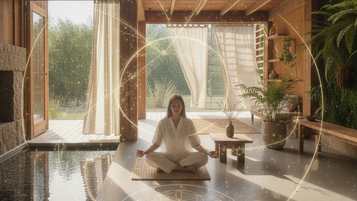
Have you ever wondered if your office could contribute to a greener future? 🌿
In an era of increasing environmental awareness, creating a sustainable workspace isn’t just a trend—it’s a responsibility for every business. However, many still feel confused and don’t know where to begin.
Don’t worry! We understand that this transition can be challenging and complex. From optimizing energy use to waste management, from improving indoor air quality to eco‑friendly interior design—there are many factors to consider. But with the right guidance, you’ll be surprised how easy it is to create a green office!
In this article, we’ll explore an exciting journey, starting from understanding sustainable office spaces, assessing the current situation, and moving toward specific steps to turn your green vision into reality. Let’s build a workplace that’s not only efficient but also environmentally friendly! 🌍💚

Understanding Sustainable Office Spaces
Definition & Importance:
A sustainable office is designed, constructed, and operated to minimize adverse environmental impacts while enhancing employee health and productivity. Its significance lies in protecting the environment, reducing costs, and fostering a positive work atmosphere.
Global Trends:
The trend of green offices is spreading worldwide. Many major companies are adopting standards like LEED, BREEAM, or WELL Building Standard. Some key trends include:
-
Using renewable energy
-
Optimizing daylight access
-
Implementing smart energy management
-
Increasing greenery within the office
Benefits for Environment & Employees:
| Environmental Benefits | Employee Benefits |
| Reduced CO₂ emissions | Improved health & morale |
| Conservation of natural resources | Increased productivity |
| Less waste generation | Higher job satisfaction |
| Ecosystem protection | A comfortable, creative workspace |
With these vast benefits, understanding and applying sustainable office space principles is a vital step for any modern business.

Assessing the Current Office Situation
To build a sustainable workspace, the first step is a comprehensive evaluation of the current status. This identifies improvement opportunities and establishes a foundation for action.
A. Setting Improvement Plans
Specify clear goals and timelines, e.g.:
-
Reduce energy consumption by 20% in 6 months
-
Increase recycling rate to 50% in 1 year
-
Improve indoor air quality within 3 months
B. Analyzing Employee Needs
Understanding employee needs is key to creating both sustainable and efficient spaces. Conduct surveys to gather insights on:
-
Satisfaction with the current workspace
-
Environmental concerns in the office
-
Employee suggestions
C. Identifying Waste Sources
Energy
| Energy | Lights on 24/7 | Install motion sensors |
| Water | Leaky faucets | Regular maintenance |
| Paper | Unnecessary printing | Encourage digital documents |
D. Examining Energy Consumption
-
Gather electricity bills for the past 12 months
-
Use energy meters for individual devices
-
Identify highest energy users
-
Compare with industry benchmarks
This gives you a comprehensive view and foundation for optimizing energy use—the next step in building a sustainable office.

Optimizing Energy Usage
Reducing energy use saves operational costs and protects the environment.
Install Smart Energy Management Systems
These systems monitor, analyze, and optimize energy use across the office. Examples:
-
Motion-sensor lights and A/C
-
Scheduling software for devices
Utilize Natural Light
Natural light saves energy and boosts mood/productivity. Tips:
-
Organize workstations by windows
-
Use smart blinds for light control
-
Install daylight tubes in windowless areas
Choose Energy-Efficient Equipment
| Device | Standard | Energy-Efficient | Savings (%) |
| Computer | 300W | 200W | 33% |
| Printer | 500W | 300W | 40% |
| Fridge | 150W | 100W | 33% |
Switch to LED Lighting
LEDs reduce energy use, have longer lifespans, and lower maintenance costs. Consider dimmable LEDs for adjustable brightness.

Waste Management & Recycling
After energy optimization, the next crucial step is effective waste management and recycling to lessen environmental impact.
Train Staff on Waste Separation
Conduct regular training sessions so everyone understands proper sorting methods and its importance.
Compost Organic Waste
Kitchen organic waste can be composted into natural fertilizer, reducing landfill load.
Reduce Single-Use Plastics
-
Provide reusable cups/mugs
-
Encourage reusable food containers
-
Remove single-use straws and utensils
Implement a Full Recycling Program
| Waste Type | Processing Method |
| Paper | Recycled into new paper |
| Plastic | Sorted by resin type, then recycled |
| Metal | Collected separately for recycling |
| Electronic | Sent to specialist e-waste centers |

Improving Indoor Air Quality
Clean air is vital for employee health and productivity. Key measures include:
Install Effective Ventilation Systems
-
Use exhaust fans in kitchens and print areas
-
Maintain HVAC regularly
-
Open windows frequently for natural airflow
Enforce a No-Smoking Policy
-
Ban indoor smoking
-
Designate outdoor smoking zones away from entrances
-
Offer smoking cessation programs
Add Indoor Plants
Some effective air-purifying plants:
-
Snake plant (removes formaldehyde, benzene)
-
Pothos (eliminates toxins)
-
Epipremnum (increases humidity)
Use Low-Toxicity Building Materials
-
Low-VOC paints & adhesives
-
Formaldehyde-free carpets/furniture
-
Non-toxic glue in plywood

Sustainable Interior Design
After improving air quality, focus on eco-friendly interiors for a sustainable and efficient office.
A. Optimize Layout for Space Efficiency
-
Foldable, multifunctional desks
-
Use vertical wall shelving
-
Create shared work areas instead of multiple private rooms
B. Prioritize Certified Eco‑Friendly Products
Look for certifications like:
-
FSC (sustainably sourced wood)
-
GREENGUARD (low chemical emissions)
-
BIFMA level (furniture sustainability rating)
C. Design Flexible, Multi‑use Spaces
-
Movable partitions
-
Convertible-use zones
-
Height-adjustable desks
D. Use Recycled‑Material Furniture
-
Chairs made from recycled plastic
-
Desks from reclaimed wood
-
Partition panels from recycled paper or textiles

Encouraging a Sustainable Lifestyle
To truly build a green workplace, encourage staff to adopt eco-lifestyles:
Reward Sustainable Behaviors
-
Organize energy-saving contests among teams
-
Offer eco-friendly gift vouchers
-
Recognize a “Green Employee of the Month”
Run Environmental Awareness Activities
-
Workshops on zero‑waste living
-
Community clean-up campaigns
-
Office tree‑planting events
Support Remote Work
-
Introduce flexible work-from-home policies
-
Provide tools/training for effective remote work
-
Use virtual meetings over in-person gatherings
Provide Bike Storage & Facilities
-
Covered bike racks
-
Locker & shower rooms
-
“Bike to Work” events
| Initiative | Benefit |
| Reward programs | Increases motivation and participation |
| Awareness events | Builds knowledge and community |
| Remote work support | Cuts commuting emissions, improves balance |
| Bike facilities | Promotes green transport, wellness |

Measurement & Continuous Improvement
To maintain and enhance sustainability, regular measurement and refinement are essential:
Monthly/Q Updates & Sharing Results
-
Report energy, water, waste stats monthly/quarterly
-
Share on bulletin boards or in internal meetings
-
Hold review sessions to discuss progress
Stay Updated with New Practices/Tech
-
Attend sustainability workshops
-
Track trends in green office design
-
Pilot new energy-saving technologies
Collect Employee Feedback
-
Conduct periodic workplace environment surveys
-
Provide a suggestion box for sustainable ideas
Establish Performance Metrics
| Metric | Target | Frequency |
| Electricity consumption | –10% per year | Monthly |
| Recycling rate | >80% | Quarterly |
| Indoor air quality (AQI) | <50 | Weekly |
| Employee satisfaction | >85% | Every 6 mos |
By implementing these measures, you continually improve office sustainability, benefiting both the environment and employee engagement.

In summary:
Creating a sustainable office isn’t just about energy efficiency—it’s about waste, air quality, eco‑design, and cultivating a green culture. From energy use to interior design and staff behavior, every step contributes to a healthier workplace and a greener future. Start today, measure your impact, and refine your efforts—the journey to sustainability is ongoing. Together, let’s build a better, greener office—and a better future.
Tags
Related news

Designing the Mindful Home: From Matter to Energy
A mindful home is not merely a place to live — it is a conscious space, where every line, material,...
View detail
Body – Mind – Qi: The Foundation of Healing Architecture
The home is not only a shelter for the body but also a space that nurtures the soul and life...
View detail
Why Do Modern Homes Make Us Tired?
1. Disconnection from Nature – Loss of Biological Rhythm Modern homes are often sealed: small windows, reflective glass, constant air...
View detail





